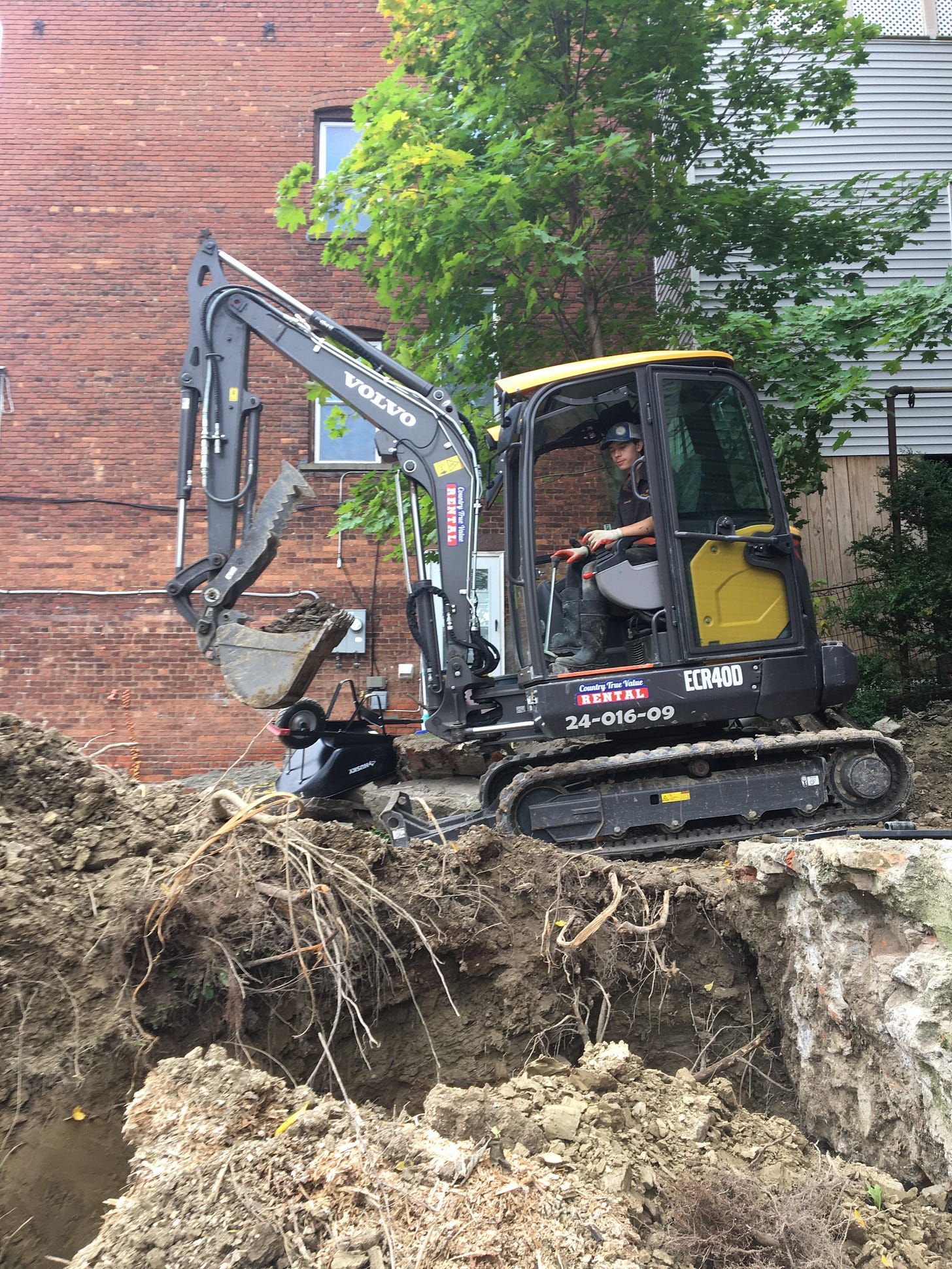Dear Bread,
‘Are you my mother?’
Cue the picture book by P.D. Eastman, in which a baby bird falls from the nest. I've always loved how the baby bird asks everything under the sun if it is his mother, including a giant yellow digger. My son recently rented an excavator, so the book has been on my mind. I love asking inanimate things intimate questions!
People sometimes call a sourdough starter “the mother” but one of my baking mothers, Sharon Burns-Leader of Bread Alone Bakery, corrects this. No one but the mother feeds the mother, so instead, she encourages bakers to think of your starter as a baby instead.
I’ve been thinking of all the mothers that feed me. My literal mom is Eve Francesca Sweeney Halloran. The other day, I found a folder of xeroxed papers, from a time capsule we tucked into the sheet rock casing my father built around some pipes in 1980. I was 13 years old, and wrote that I thought I’d grow up to be an architect or an artist, like my mother. I’m grateful that she modeled & models a life of creativity, making room for all of us, and herself, to make art.
Luckily, the freedom to play and explore has never left me. I noticed this as I was teaching a class at CRAFT at Chatham University, near Pittsburgh. I came here to speak at a regional grains event, Grainstorm. I moderated a panel about regional grain organizations, featuring AGC (Artisan Grain Collaborative), CRAFT, and the Common Grain Alliance. I also taught a class in making pampushky – garlic rolls that are served with borscht. As I guided people through the process, I could hardly agree with the timelines I’d written in the recipe! Sometimes, a whole grain sourdough needs all day to get ready to bake, not the 2-4 hours I’d indicated.
I didn’t keep my thoughts to myself. Instead, I encouraged people to develop a familiarity with the process, and not feel nervous as they baked at home. I had stayed away from sourdough baking for years because I thought that I’d have to learn, and precisely practice, a complex system. The concepts seemed abstract, and intimidated me. Yet, I’ve since learned that sourdough baking is more flexible than yeasted doughs. Yes, you can be a perfectionist, but also, you can be a ‘good enough’ mother to your sourdough.
My best friend in baking, Ellie Markovitch proves that over and over again, and with her I have discovered an especially fluid approach, using a cold-risen levain. Ukrainian activist and cookbook author Olia Hercules introduced us to this style of preferment, which sits in the fridge until you use it. Initially, this method stumped me. How could the starter grow in the cold? But it does, and as I’ve been distracted by writing, I’ve pushed the timing to the outer limits, and Iet the levain rest for 10 days. Even though it sank in the jar and just looked like paste, it still made beautiful rolls! Here is my pampushky recipe, along with the varenki recipe Ellie wrote – we put these together last spring to fundraise for Ukraine.
Ukraine is one of our wheat mothers. Immigrants from Crimea brought Turkey red wheats to Kansas in the 1870s; by the early 20th century, Turkey red wheat was being crossed with other types of wheat to breed the varieties that developed our breadbasket. In Canada, their mother wheat is Red Fife.
Mother wheat – pairing those two words sounds odd, because I’ve grown up in a culture that views men’s paid work as foundational. Yet from Demeter and Ceres, through Indigenous American corn mother ceremonies, worshiping staple grains as mothers is a deep tradition and often, a spiritual practice.
And my writing mothers – who are they? For a while I was obsessed with Charlotte Brontë, and Angela Carter. Rebecca Solnit and Olivia Laing. Shirley Jackson has been haunting me lately. I read her novel about a Bennington College student, Hangsaman. What an incredible book! Jackson pulls the psychic airplane close for a tight bird’s eye view of young women’s minds.
I loved that book so much that I read her letters and a biography. The closing lines of Ruth Franklin’s Shirley Jackson: A Rather Haunted Life ring a lot of bells. “She believed her role as a writer was to draw back the curtain on the darkness within the human psyche.…Her insistence on telling unpleasant truths is surely part of the reason her work has been less appreciated than it deserves to be.”
The first unpleasant truth she delivered broadly was “The Lottery.”1 The New Yorker published this short story in 1948, sparking a mass of mail that she pasted in a scrapbook. America didn’t know what to do with fiction that revealed our clannish tendencies.
During the same era, another American woman writer, Rachel Carson was writing about the environment, drawing our eyes to the beauty of biology, and pulling back the curtain on the dangers of pesticides. Her 1962 nonfiction book Silent Spring has been credited with starting the environmental movement. Her life and work inspired the sustainability & food studies programs here at Chatham.
And what ideas mothered her? Rachel Carson’s mother read and applied Anna Botsford Comstock's Handbook for Nature Study at home. This incredible text carried the message of a movement that tried to stem the flow of farm kids to cities, by cultivating empathy with nature, and wonder about your surroundings.
Rachel Carson wrote a short book called The Sense of Wonder, and you can hear nature study principles in her words. Was she aware of that influence?
Do we ever know how we grow?
Maybe mothering is bringing a sense of wonder to a project or a person. What do you think dear Bread? Is wonder what you give us? Is wonder what you need in return?
Love, Amy
“Deer City,” is a short story of mine, and also about community violence. Its recent publication in Gargoyle 75, the latest and final issue of a magnificent literary journal, is part of what got me on my Shirley Jackson jag.





